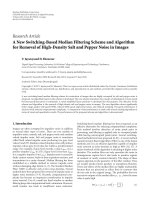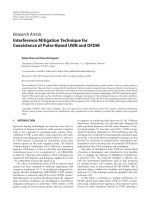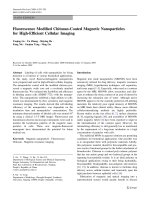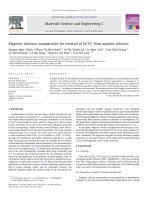Surface functionalized magnetic nanoparticles for separation of chiral biomolecules, pharmaceuticals and endocrine disrupting compounds
Bạn đang xem bản rút gọn của tài liệu. Xem và tải ngay bản đầy đủ của tài liệu tại đây (5.4 MB, 306 trang )
SURFACE FUNCTIONALIZED MAGNETIC
NANOPARTICLES FOR SEPARATION OF CHIRAL
BIOMOLECULES, PHARMACEUTICALS AND
ENDOCRINE DISRUPTING COMPOUNDS
SUDIPA GHOSH
NATIONAL UNIVERISTY OF SINGAPORE
2012
SURFACE FUNCTIONALIZED MAGNETIC
NANOPARTICLES FOR SEPARATION OF CHIRAL
BIOMOLECULES, PHARMACEUTICALS AND
ENDOCRINE DISRUPTING COMPOUNDS
SUDIPA GHOSH
B.Sc. (Chemical Engineering)
Bangladesh University of Engineering & Technology
A THESIS SUBMITTED
FOR THE DEGREE OF DOCTOR OF PHILOSOPHY
DEPARTMENT OF CHEMICAL & BIOMOLECULAR
ENGINEERING
NATIONAL UNIVERSITY OF SINGAPORE
2012
Acknowledgements
i
Acknowledgements
I would like to take this opportunity to express my heartfelt gratefulness and admiration
to my supervisors, Professor Mohammad Shahab Uddin (International Islamic
Univeristy, Malaysia) and Associate Professor Kus Hidajat, whose encouragement,
guidance and full support from the initial level enabled me to come up to this point.
I would give much credit to my husband, beloved parents and family members for their
endless love, understanding, moral support and inspiration during my research.
I would like to thank all staff members in the Department of Chemical and
Biomolecular Engineering and my laboratory colleagues who have supported me
throughout this project work.
Finally, I would like to thank National University of Singapore for providing me the
Research Scholarship and department of Chemical and Biomolecular Engineering for
providing all the facilities for carrying out this research work.
Sudipa Ghosh
December, 2012
Table of contents
ii
Table of contents
Acknowledgements i
Table of contents ii
Summary viii
Nomenclature xiii
Abbreviations xiv
List of figures xvii
List of tables xxiii
Chapter 1: Introduction 1
1.1 Background on magnetic separation 1
1.2 Surface functionalization of magnetic particles 2
1.3 Research objectives 4
1.4 Organization of the Thesis 6
Chapter 2: Literature review 8
2.1 Magnetic separation 8
2.1.1 Classifications of magnetic separation 9
2.1.2 Principle of magnetic separation 9
2.1.3 Interaction forces involved in magnetic separation 11
2.1.4 Advantages and disadvantages of magnetic separation 14
2.2 Magnetic particle 15
2.2.1 Magnetic forces 17
2.3 Superparamagnetic nanoparticles 19
2.3.1 Properties of superparamagnetic nanoparticles 21
2.3.2 Synthesis of superparamagnetic nanoparticles 22
2.3.3 Surface modification of magnetic nanoparticles 24
2.3.3.1 Surface functionalization with monomeric stabilizer 25
2.3.3.1.1 Coated with carboxylates 25
2.3.3.1.2 Coated with phosphates 25
2.3.3.2 Surface functionalization with inorganic materials 26
2.3.3.2.1 Coated with silica 26
2.3.3.2.2 Coated with gold 27
2.3.3.3 Surface functionalization with polymer stabilizers 27
Table of contents
iii
2.3.3.3.1 Coated with dextran and polyethylene glycol (PEG) 27
2.3.3.3.2 Coated with polyvenylalchohol (PVA) 28
2.3.3.3.3 Coated with alginate 29
2.3.3.3.4 Coated with chitosan 29
2.3.3.3.5 Coated with thermosensitive polymer 30
2.3.3.3.6 Coated with cyclodextrin 31
2.4 Separation of chiral amino acids 35
2.5 Removal of pharmaceuticals and endocrine disrupting compounds (EDCs) 46
2.6 Adsorption and desorption 63
2.6.1 Adsorption isotherm 64
2.6.1.1 Adsorption isotherm models 64
2.6.1.1.1 Langmuir model 64
2.6.1.1.2 Freundlich model 65
2.6.1.1.3 Langmuir-Freundlich model 66
2.6.2 Adsorption kinetics 66
2.7 Desorption study 68
2.8 Scope of the Thesis 69
Chapter 3: Materials and Methods 73
3.1 Materials 73
3.2 Methods 77
3.2.1 Synthesis of bare magnetic nanoparticles (bare MNPs) 77
3.2.2 Silica coated magnetic nanoparticles (Fe
3
O
4
/SiO
2
MNPs) 77
3.2.3 Synthesis of carboxymethyl-β-cyclodextrin (CMCD) 78
3.2.4 Coating of CMCD on Fe
3
O
4
/SiO
2
MNPs 79
3.2.5 Synthesis of 6-Deoxy-6-(p-toluenesulfonyl)-β-cyclodextrin (Ts-β-CD) 80
3.2.6 Synthesis of 6 deoxy-6-ethylenediamino-β-cyclodextrin (β-CDen) 81
3.2.7 TDGA coated magnetic nanoparticles (TDGA-MNPs) 81
3.2.8 β-CDen conjugated magnetic nanoparticles (CDen-MNPs) 82
3.3 Adsorption experiments 83
3.3.1 Adsorption of chiral aromatic amino acids on Fe
3
O
4
/SiO
2
/CMCD MNPs. 83
3.3.1.1 Effect of initial pH 83
3.3.1.2 Effect of temperature 85
3.3.1.3 Kinetic studies 85
3.3.1.4 Desorption studies 85
Table of contents
iv
3.3.2 Enantioselective separation of chiral aromatic amino acids 86
3.3.2.1 Adsorption of racemic amino acids 86
3.3.2.2 Measurement of enantiomeric excess 87
3.3.2.3 Flurometric experiments 88
3.3.3 Adsorption of pharmaceuticals and EDCs on CDen MNPs 88
3.3.3.1 Kinetic studies and effect of pH studies 88
3.3.3.2 Equilibrium studies 89
3.3.3.3 Adsorption of a mixture of pharmaceuticals 90
3.3.3.4 Desorption of pharmaceuticals and EDC 90
3.3.3.5 Preparation of inclusion complex for investigation by FTIR spectroscopy
91
3.3.4 Adsorption of beta-blocker, propranolol onto Fe
3
O
4
/SiO
2
/CMCD MNPs . 91
3.3.4.1 Adsorption experiments 91
3.3.4.2 Flurometric experiments 92
3.3.4.3 Desorption studies 92
3.4 Analytical Methods 93
3.4.1 Fourier-transform Infrared (FTIR) Spectroscopy 93
3.4.2 Transmission Electron Microscopy (TEM) 94
3.4.3 X-ray Diffraction (XRD) analysis 94
3.4.4 Vibrating Sample Magnetometer (VSM) 95
3.4.5 Brunauer-Emmett-Teller (BET) method 95
3.4.6 Zeta Potential analysis 96
3.4.7 Thermogravimetric Analysis (TGA) 96
3.4.8 X-ray Photoelectron Spectroscopy (XPS) 96
3.4.9 Fluorescence 97
Chapter 4: Characterization of silica and carboxymethyl-β-cyclodextrin bonded
magnetic nanoparticles 98
4.1 Introduction 98
4.2 Results and discussion 101
4.2.1 Characterization of silica and CMCD coated magnetic nanoparticle 101
4.2.1.1 FTIR spectroscopy 101
4.2.1.2 TEM images and surface area measurements 103
4.2.1.3 X-ray Diffraction analysis 107
4.2.1.4 XPS results 108
Table of contents
v
4.2.1.5 VSM results 111
4.2.1.6 Zeta potential measurement 112
4.3 Conclusions 113
Chapter 5: Adsorption/desorption of chiral aromatic amino acids onto carboxymethyl-
β-cyclodextrin bonded Fe
3
O
4
/SiO
2
core-shell nanoparticles 114
5.1 Introduction 114
5.2 Results and discussion 116
5.2.1 Adsorption of chiral aromatic amino acid enantiomers 116
5.2.1.1 Equilibrium study of single amino acid enantiomers 116
5.2.1.2 Adsorption at different pH 121
5.2.1.3 Adsorption at different temperatures 129
5.2.1.4 Comparison of adsorption capacities of different amino acids 135
5.2.2 Adsorption kinetics 137
5.2.3 Desorption studies 141
5.2.4 Adsorption mechanism 143
5.3 Conclusions 146
Chapter 6: Enantioselective separation of chiral aromatic amino acids with surface
functionalized magnetic nanoparticles 147
6.1 Introduction 147
6.2 Results and discussion 151
6.2.1. Enantioseparation of aromatic amino acids 151
6.2.1.1 Adsorption separation of single enantiomers and racemic amino acids 151
6.2.1.2 Linearity, limits of detection, reproducibility of the developed method 160
6.2.1.3 Investigations on the mechanism of sorption resolution by XPS and FTIR
spectroscopy 162
6.2.2 Flurometric titrations 171
6.3 Conclusions 175
Chapter 7: Adsorptive removal of emerging contaminants from aqueous solutions
using superparamagnetic Fe
3
O
4
nanoparticles bearing aminated β-cyclodextrin 176
7.1 Introduction 176
7.2 Results and discussions 179
7.2.1 Characterization of as-synthesized magnetic nanoparticles 179
7.2.1.1 FTIR analysis 181
7.2.1.2 TEM images 182
Table of contents
vi
7.2.1.3 XRD analysis 183
7.2.1.4 X-ray photoelectron spectroscopy (XPS) analysis 184
7.2.1.5 Thermogravimetric (TGA) analysis 186
7.2.1.6 VSM analysis 188
7.3 Adsorption study 189
7.3.1 Effect of initial pH 189
7.3.2 Effect of contact time and adsorption kinetics 192
7.3.3 Isotherm test and role of physicochemical properties of pollutants 196
7.3.4 Adsorption of a mixture of pharmaceuticals and EDCs 201
7.3.5 Desorption study 202
7.3.6 Interaction of pharmaceuticals/EDC and β-CDen 203
7.4 Conclusions 206
Chapter 8: Adsorption/desorption of beta-blocker propranolol from aqueous solution
by surface functionalized magnetic nanoparticles 208
8.1 Introduction 208
8.2 Results and discussion 211
8.2.1 Adsorption of propranolol 211
8.2.1.1 Effect of initial pH 211
8.2.1.2 Effect of contact time and adsorption kinetics 213
8.2.1.3 Adsorption isotherm 216
8.2.2 Investigation of adsorption mechanism with FTIR and XPS spectroscopy
220
8.2.3 Spectroflurometry measurements and binding constant of
CMCD/propranolol 225
8.2.4 Desorption studies 228
8.3 Conclusions 229
Chapter 9: Conclusions and recommendations 231
9.1 Conclusions 231
9.2 Recommendations 236
9.2.1 Separation of chiral biomolecules 237
9.2.2Removal of environmental pollutants 239
9.2.3 Multifunctional nanoparticles 240
Table of contents
vii
9.2.4 Magnetic nanoparticles for separation of bio-molecules and waste-water
purification in large scale using High Gradient Magnetic Separation (HGMS)
system 241
Summary
viii
Summary
In the past decade, synthesis of superparamagnetic nanoparticles has been intensively
developed not only for its fundamental scientific interest but also for many
technological applications. A wide range of metal, magnetic, semiconductor and
polymer nanoparticles with tunable sizes and properties can be synthesized by wet-
chemical techniques. Magnetic nanoparticles (MNPs) have the advantages of good
dispersibility in various solvents, high surface area and strong magnetic responsivity.
These magnetic nanoparticles have emerged as excellent materials in many fields, such
as immobilized catalysis, labelling and sorting of biological species, targeted drug or
gene delivery, magnetic resonance imaging, and hyperthermia treatment. An important
application of these nanoparticles is magnetic separation. Because of strong magnetism,
these MNPs can be used as separable supports for adsorbent, which makes profound
contribution to green chemistry. The surfaces of these particles are often modified by
capping agents such as polymers, inorganic metals or oxides, and surfactants to make
them stable, biocompatible, and suitable for further functionalization and applications.
Cyclodextrins (CDs) are natural products which are produced from starch by means of
enzymatic conversion. Typical cyclodextrins contain a number of glucose monomers
ranging from six to eight units in a ring, creating a cone shape. CDs are promising tools
for applications in drug carrier systems, nano reactors, bioactive supramolecular
assemblies, molecular recognition and catalysis. The combination of CDs and inorganic
nanoparticles has attracted increasing attention. These particles can be utilized for
sensing, chiroselective analysis, controlled hydrophobic drug delivery and so on. In this
work, magnetite silica particles coated with carboxymethyl-β-cyclodextrin (CMCD) are
Summary
ix
synthesized via layer-by-layer method. Cyclodextrin derivatives are synthesized and
applied as chiral selectors because of their favorable properties (stability, low cost, UV
transparency, inertness, etc.). The bare MNPs are prepared by chemical precipitation of
Fe
2+
and Fe
3+
salts in the ratio of 1:2 under alkaline and inert condition. Afterwards,
surface of these particles are modified by silica to achieve stability against
agglomeration and further modification of the particles‟ surface is done by coating with
CMCD. The functionalized magnetic nanoparticles (core-shell) are characterized using
several analytical methods namely Fourier Transform Infra-Red (FTIR) spectroscopy,
Transmission Electron Microscopy (TEM), X-ray Photoelectron Spectroscopy (XPS),
X-ray Diffraction (XRD) and Vibrating Sample Magnetometer (VSM). The thickness
of silica shell is about 9 nm and average size of Fe
3
O
4
/SiO
2
/CMCD MNP (silica and
CMCD coated magnetic nanoparticle) is around 29 nm.
The as-synthesized particles are used to adsorb single amino acid enantiomers namely
D- and L- tryptophan (Trp), D- and L-phenylalanine (Phe) and D- and L-tyrosine (Tyr).
Adsorption of these amino acid enantiomers on Fe
3
O
4
/SiO
2
/CMCD MNPs are also
studied in detail as function of initial solution pH and temperature. High adsorption
capacities of these MNPs are observed at pH around isoelectric points (pI) of the amino
acids and at temperature 25°C. Noteworthy, remarkable differences are observed
between adsorption capacities of the particles toward the above mentioned D- and L-
enantiomers of amino acids. At low concentration of amino acids, adsorption capacities
are compared and in same conditions, adsorption capacities of the particles toward
amino acids are in the order of tryptophan> phenylalanine>tyrosine. It seems that
structure and hydrophobicity of amino acid molecules are responsible for difference in
adsorption, by influencing the strength of interactions between amino acid molecules
and the particles. It has been shown that adsorption of amino acids are consistent with
Summary
x
Freundlich isotherm equation. Finally, desorption of amino acids is carried out using
methanol as eluent and it is found that around 90% desorption of L-amino acids and
(75-80) % desorption of D-amino acids are achieved under described condition.
Moreover, chiral resolution of racemic aromatic amino acids, DL-tryptophan (Trp), DL-
phenylalanine (Phe), DL- tyrosine (Tyr) from phosphate buffer solution is achieved in
present study employing the concept of selective adsorption by surface functionalized
magnetic nanoparticles. Resolution of enantiomers from racemic mixture is quantified
in terms of enantiomeric excess using chromatographic methods. The nanoparticles
selectively adsorb L-enantiomer of Trp, Tyr, and Phe from racemic mixture and the
enantiomeric excesses (e.e) are determined as 94%, 73% and 58% for Trp, Phe and Tyr
enantiomers, respectively. Furthermore, XPS studies explore that interaction of the
enantiomers is mainly attributed to the formation of hydrogen bond between amino
group of the amino acid molecule and secondary hydroxyl group of CMCD on the
particle surface. Noteworthy, FTIR studies prove that the enantiomers interact with
hydrophobic cavity of cyclodextrin molecule to from inclusion complex. Furthermore,
higher binding constants are obtained for inclusion complexation of CMCD with L-
enantiomers compared to D-enantiomers using flurometric titrations which might have
yielded enantioselective properties of the CMCD functionalized magnetite silica
nanoparticles.
Afterwards, synthetic strategies are developed for grafting of amino-β-cyclodextrin (β-
CDen) onto superparamagnetic Fe
3
O
4
nanoparticles by layer-by-layer methods. β-CDen
(en:-NHCH
2
CH
2
NH
2
) functionalized magnetic nanoparticles are fabricated by grafting
mono-6-ethylenediamino-6-deoxy-β-CD (β-CDen) onto thiodiglycolic acid (TDGA)
modified magnetic nanoparticles. For confirmation of grafting of β-CDen onto nano-
Summary
xi
sized magnetic particles, characterizations are carried out using FTIR spectroscopy,
TEM, XPS, XRD analysis, VSM and Thermogravimetric Analysis (TGA).
Characterizations by these methods reveal that CDen-MNPs are superparamagnetic
nanoparticles with mean diameter of around 11.5 nm. Thermogravimetric analysis
indicates that the amount of β-CDen grafted onto the CDen-MNPs is 0.050 mmolg
−1
.
These as-synthesized β-CDen bonded magnetic nanoparticles with combined effect of
inclusion properties of CD and magnetic properties of iron oxide are used as potential
adsorbent for removal of two pharmaceuticals, carbamazepine (CBZ) and naproxen
(NAP) and an endocrine disrupting agent, bisphenol A (BPA) from aqueous solution.
Adsorption of the pharmaceuticals and endocrine disrupting compound is found to be
pH dependent. β-CDen being grafted on TDGA-coated Fe
3
O
4
nanoparticle contributes
to an enhancement of adsorption capacities because of the inclusion abilities of its
hydrophobic cavity with organic contaminants through host-guest interactions.
Experimental data for adsorption of these three chemicals are fitted well to Freundlich
isotherm model. Under same experimental conditions (pH 7 and 25°C), adsorption
capacities of β-CDen-MNPs toward the three above mentioned targets are found to be
in the order of carbamazepine> naproxen> bisphenol A. For better understanding of the
interaction between target molecules and CDen MNPs, their inclusion complexes are
studied by FTIR spectroscopy which confirms formation of inclusion complexes
through van der Waals interaction. Desorption study of pharmaceuticals and EDC
shows that ethanol could be used as desorbing agent but for complete desorption
multiple steps may be required.
Adsorption of beta-blocker, propranolol utilizing silica and CMCD modified magnetic
nanoparticles (Fe
3
O
4
/SiO
2
/CMCD MNPs) from phosphate buffer solution is also
studied as function of initial solution pH and initial concentration of sorbate.
Summary
xii
Adsorption capacity of the adsorbent increases as pH is increased from 3 to 9 and then
reaches the plateau at pH 11. It appears that hydrophobicity of beta-blocker, propranolol
affects the interaction with cyclodextrin functionalized magnetic nanoparticles as well
as adsorption capacity of the MNPs. Sorption capacity of the nanoadsorbents bearing
cyclodextrin is compared and is found to be higher than that of bare magnetic
nanoparticles, which is due to presence of cyclodextrin on nanoparticles‟ surface.
Kinetic studies reveal that adsorption of propranolol on the nanoadsorbents is very fast
and is completed within 1 hr. The kinetic data of propranolol adsorption is found to
follow pseudo-second-order kinetic model. Equilibrium data in aqueous solution is well
represented by Freundlich isotherm model. XPS analysis reveals that propranolol
adsorption onto the magnetic nanoparticle mainly involve nitrogen atoms to form
surface complexes. In addition, FTIR spectroscopy is applied to investigate adsorption
mechanism. Finally, desorption studies are carried out and 50% methanol solution is
found to be effective for almost complete desorption. All these experimental results
show that β-cyclodextrin derivative conjugated MNPs could be promising tools for
separation of chiral molecules as well as separation/ removal of pharmaceuticals,
endocrine disrupting compounds and beta-blockers from waste-water.
Nomenclature
xiii
Nomenclature
Symbols
H
Magnetic field strength
B
Magnetic flux density
µ
0
Permeability of free space
M
Magnetic moment per unit volume
M
s
Saturation magnetization
M
r
Residual magnetization
H
c
Coercive field
F
m
Magnetic force
χ
Magnetic susceptibility
r
Radius of particle
k
B
Boltzmann constant
T
Temperature
Tc
Curie temperature
T
N
Neel temperature
C
Material specific curie constant
K
u
Crystalline magneto anisotropy
C
i
Initial concentration (mM or ppm)
C
e
Equilibrium concentration (mM or ppm)
Q
m
Maximum adsorption capacity (mg/g)
Q
e
Adsorption capacity at equilibrium (mg/g)
Q
t
Adsorption capacity at any time (mg/g)
k
L
Langmuir constant
Nomenclature
xiv
k
F
Freundlich constant
n
Empirical constant
k
1
Pseudo first order rate constant
k
2
Pseudo second order rate constant
θ
Half diffraction angle (deg)
λ
Wavelength of X-ray (nm)
β
Half width of XRD diffraction line (red)
Abbreviations
CD
Cyclodextrin
α-CD
α-cyclodextrin
β-CD
β-cyclodextrin
γ-CD
γ-cyclodextrin
S-β-CD
Sulfated-β-cyclodextrin
CMCD
Carboxymethyl-β-cyclodextrin
Ts-β-CD
Monotosyl- β-cyclodextrin
β-CDen
6 deoxy-6-ethylenediamino-β-cyclodextrin (amino-cyclodextrin)
MNP
Magnetic nanoparticle
CMP
as-synthesized citric acid modified particle
Fe
3
O
4
/SiO
2
MNP
as-synthesized silica coated magnetic nanoparticle
Fe
3
O
4
/SiO
2
/CMCD MNP
as-synthesized silica and CMCD coated magnetic nanoparticle
CDen MNP
as-synthesized β-CDen coated magnetic nanoparticle
TDGA MNP
as-synthesized thiodiglycolic acid coated magnetic nanoparticle
PhAC
Pharmaceutically active compound
EDC
Endocrine disrupting compound
Nomenclature
xv
Trp
Tryptophan
Phe
Phenylalanine
Tyr
Tyrosine
CBZ
Carbamazepine
NAP
Naproxen
BPA
Bisphenol A
CSP
Chiral Stationary Phase
Dns
Dansyl (5-(dimethyl amino)naphthalene-1-sulfonyl)
DNB
3, 5-dinitrobenzoyl
DNFB
2, 4 dinitroflurobenzene
FITC
Fluorescein isothiocyanate
Fmoc
Fluorenylmethyl chloroformate
Ala
Alanine
Arg
Arginine
Asn
Asparagine
Asp
Aspartic acid
Cys
Cysteine
Eth
Ethionine
Glu
Glutamic acid
Gln
Glutamine
Gly
Glycine
His
Histidine
Ile
Isoleucine
Leu
Leucine
Nle
Norleucine
Nomenclature
xvi
Pro
Proline
Met
Methionine
Ser
Serine
Thr
Threonine
Val
Valine
Nva
Norvaline
Lys
Lysine
TEOS
Tetraethyl orthosilicate
TDGA
Thiodiglycolic acid
FTIR
Fourier-transform Infrared Spectroscopy
TEM
Transmission Electron Microscopy
XPS
X-ray Photoelectron Spectroscopy
XRD
X-ray Diffraction
TGA
Thermogravimetric Analysis
VSM
Vibrating Sample Magnetometer
BET
Brunauer-Emmett-Teller method
HPLC
High Performance Liquid Chromatography
List of figures
xvii
List of figures
Figure 2-1 Schematic diagram of separation of non-magnetic targets. 11
Figure 2-2 Schematic illustrating the arrangements of magnetic dipoles for five
different types of materials in the absence or presence of an external magnetic field
(H) [4]. 16
Figure 2-3 The typical magnetization curve of a ferro- or ferromagnetic material [4]. . 18
Figure 2-4 (a) Schematic illustrating the dependence of magnetic coercivity on particle
size, (b) Magnetization characteristics of superparamagnetic (solid line),
paramagnetic (dotted line) and ferromagnetic (dashed line) particles [4] 20
Figure 2-6 Different approaches to surface modifications, (a) surface treatment to attain
thermodynamic stability in dispersion, (b) surface adsorption of a surfactant or a
block copolymer, (c) surface modification to make the nanoparticle functional
[87]. 24
Figure 2-7 Molecular structures of CDs [149]. 31
Figure 3-1 Scheme representation of silica and CMCD coating on bare magnetic
nanoparticles. 80
Figure 3-2 Preparation steps for fabricating β-CDen functionalized magnetic
nanoparticles. 83
Figure 4-1 FTIR spectra of (a) bare MNPs, (b) CMPs, (c) Fe
3
O
4
/SiO
2
MNPs, (d)
Fe
3
O
4
/SiO
2
/CMCD MNPs. 102
Figure 4-2 (a) TEM image and (b) size distribution of bare MNPs (scale bar is 50 nm).
104
Figure 4-2 (c) TEM image and (d) size distribution of CMPs (scale bar is 20 nm) 105
Figure 4-2 (e) TEM image and (f) size distribution of Fe
3
O
4
/SiO
2
/CMCD MNPs (scale
bar is 60 nm). 106
Figure 4-3 XRD patterns of (a) CMPs, (b) Fe
3
O
4
/SiO
2
MNPs, (c) Fe
3
O
4
/SiO
2
/CMCD
MNPs. 108
Figure 4-4 XPS wide scan spectra of (a) CMPs, (b) Fe
3
O
4
/SiO
2
MNPs, (c)
Fe
3
O
4
/SiO
2
/CMCD MNPs. 109
Figure 4-5 XPS wide scan spectra of (a) Si2p of Fe
3
O
4
/SiO
2
MNPs, (b) O1s of CMPs
and Fe
3
O
4
/SiO
2
MNPs, (c) C1s spectrum of Fe
3
O
4
/SiO
2
/CMCD MNPs. 110
List of figures
xviii
Figure 4-6 Magnetization vs magnetic field curves for (a) bare MNPs and (b)
Fe
3
O
4
/SiO
2
/CMCD MNPs obtained by VSM at 25°C. 112
Figure 4-7 Zeta potential of bare MNPs, Fe
3
O
4
/SiO
2
MNPs and Fe
3
O
4
/SiO
2
/CMCD
MNPs (20mg/100mL) in 10
-3
NaCl solution at different pH. 113
Figure 5-1 Structures of amino acid enantiomers: (a) L-Trp, (b) D-Trp, (c) L-Phe, (d)
D-Phe,(e) L-Tyr and (f) D-Tyr. 117
Figure 5-2 Adsorption equilibrium isotherms for: (a) L- and D-Trp, (b) L- and D-Phe,
(c) L- and D-Tyr (pH 7 and ionic strength 0.03M). 118
Figure 5-3 Zeta potential of L-Trp, L-Phe and L-Tyr (20mg/100mL) in 10
-3
M NaCl at
different pH. 122
Figure 5-4 Adsorption equilibrium isotherms of (a) L- and (b) D-Trp at pH 4, pH 5, pH
5.9, pH 7 (25°C and ionic strength 0.03M). 124
Figure 5-5 Adsorption equilibrium isotherms of (a) L- and (b) D-Phe at pH 4, pH 5, pH
5.5 and pH 7(25°C and ionic strength 0.03M). 125
Figure 5-6 Adsorption equilibrium isotherms of (a) L- and (b) D-Tyr at pH 4, pH 5, pH
5.6 and pH 7 (25°C and ionic strength 0.03M). 126
Figure 5-7 Effect of pH on adsorption: (a) D- and L-Trp, (b) D- and L-Phe, (c) D- and
L-Tyr. (25°C and ionic strength 0.03M). 128
Figure 5-8 Adsorption equilibrium isotherms of (a) L- and D-Trp at 25°C, 35°C and
50°C (pH 5.9 and ionic strength 0.03M). 130
Figure 5-9 Adsorption equilibrium isotherms of (a) L- and (b) D-Phe at 25°C, 35°C and
50°C (pH 5.5 and ionic strength 0.03M). 131
Figure 5-10 Adsorption equilibrium isotherms of (a) L- and (b) D-Tyr at 25°C, 35°C
and 50°C (pH 5.6 and ionic strength 0.03M). 132
Figure 5-11 Effect of temperature on adsorption: (a) D- and L-Trp, (b) D- and L-Phe,
(c) D- and L-Tyr. (ionic strength 0.03M). 134
Figure 5-12 Adsorption isotherms for (a) L-Trp, L-Phe, L-Tyr and (b) D-Trp, D-Phe, D-
Tyr at initial concentrations of (0.25-2 mM) incubated with 50 mg of
Fe
3
O
4
/SiO
2
/CMCD MNPs. 136
Figure 5-13 Effect of contact time on adsorption of D-/L-Trp on Fe
3
O
4
/SiO
2
/CMCD
MNPs. 137
Figure 5-14 Effect of contact time on adsorption of D-/L-Phe on Fe
3
O
4
/SiO
2
/CMCD
MNPs. 138
List of figures
xix
Figure 5-15 Effect of contact time on adsorption of D-/L-Tyr on Fe
3
O
4
/SiO
2
/CMCD
MNPs. 138
Figure 5-16 Desorption of L-Trp, L-Phe, L-Tyr from Fe
3
O
4
/SiO
2
/CMCD MNPs in
methanol. Adsorption condition: Fe
3
O
4
/SiO
2
/CMCD MNPs 50 mg; L-Trp/L-
Phe/L-Tyr: 2 mM; pH 6; temperature 25°C, contact time 24 hrs. Desorption
condition Fe
3
O
4
/SiO
2
/CMCD MNPs: 50 mg; temperature 25°C, contact time 24
hrs. 142
Figure 5-17 Desorption of D-Trp, D-Phe, D-Tyr from Fe
3
O
4
/SiO
2
/CMCD MNPs in
methanol. Adsorption condition: Fe
3
O
4
/SiO
2
/CMCD MNPs 50 mg; L-Trp/L-
Phe/L-Tyr: 2 mM; pH 6; temperature 25°C, contact time 24 hrs. Desorption
condition Fe
3
O
4
/SiO
2
/CMCD MNPs: 50 mg; temperature 25°C, contact time 24
hrs. 142
Figure 5-18 FTIR spectra of L-tryptophan. 143
Figure 5-19 FTIR spectra of Fe
3
O
4
/SiO
2
/CMCD MNPs after adsorption of L-
tryptophan. 145
Figure 5-20 FTIR spectra of Fe
3
O
4
/SiO
2
/CMCD MNPs after adsorption of D-
tryptophan. 145
Figure 6-1 Schematic structures of the molecules: (a) DL-Trp, (b) L-Trp, (c) D-Trp, (d)
DL-Phe, (e) L-Phe, (f) D-Phe, (g) DL-Tyr, (h) L-Tyr, (i) D-Tyr. 152
Figure 6-2 Adsorption equilibrium isotherms for: (a) L-Trp, (b) D-Trp, (c) L-Phe, (d)
D-Phe, (e) L-Tyr and (f) D-Tyr at pH 6 (25°C and ionic strength 0.03M). 153
Figure 6-3.1 Chromatogram for HPLC separation of (a) DL-Trp (2 mM) before
adsorption, (b) DL-Trp after adsorption onto the modified magnetic nanoparticles.
Column Chirex Phenomenx, (150 mm×4.6mmI.D.), maintained at 18°C, mobile
phase 2 mM copper sulphate: methanol (70:30).Isocratic elution was carried out as
described in the experimental condition at flow rate of 0.7 mL/min. Detection UV
258 nm. 158
Figure 6-3.2 Chromatogram for HPLC separation of (a) DL-Phe (2mM) before
adsorption, (b) DL-Phe after adsorption onto the modified magnetic nanoparticles.
Column Chirex Phenomenx, (150 mm×4.6mmI.D.), maintained at 18°C, mobile
phase 2 mM copper sulphate: methanol (70:30).Isocratic elution was carried out as
described in the experimental condition at flow rate of 0.7 mL/min. Detection UV
258 nm. 159
List of figures
xx
Figure 6-3.3 Chromatogram for HPLC separation of (a) DL-Tyr (2mM) before
adsorption, (b) DL-Tyr after adsorption onto the modified magnetic nanoparticles.
Column Chirex Phenomenx, (150 mm×4.6mmI.D.), maintained at 18°C, mobile
phase 2 mM copper sulphate: methanol (70:30). Isocratic elution was carried out
as described in the experimental condition at flow rate of 0.7 mL/min. Detection
UV 258 nm. 160
Figure 6-4 FTIR spectra of (a) DL-Trp after adsorption, (b) DL-Trp, (c)
Fe
3
O
4
/SiO
2
/CMCD MNPs, (d) DL-Phe, (e) DL-Phe after adsorption, (f) DL-Tyr,
(g) DL-Tyr after adsorption. 163
Figure 6-5.1 XPS N1s spectra of (a) DL-Trp, (b) DL-Trp after adsorption 166
Figure 6-5.2 XPS N1s spectra of (a) DL-Phe, (b) DL-Phe after adsorption. 167
Figure 6-5.3 XPS N1s spectra of (a) DL-Tyr, (b) DL-Tyr after adsorption 168
Figure 6-6 (a) Structure of β- cyclodextrin, (b) molecular dimensions and functional
structural scheme of β-cyclodextrin, (c) simplified schematic showing adsorption
mechanism of L-Trp onto Fe
3
O
4
/SiO
2
/CMCD MNPs, (d) simplified schematic
showing adsorption mechanism of D-Trp onto Fe
3
O
4
/SiO
2
/CMCD MNPs. 171
Figure 6-7 (a) Fluorescence spectrum of L-tryptophan upon addition of CMCD of
various concentrations at 25°C; [L-tryptophan]=3×10
-5
mol/L, concentration of
CMCD: (1) 0, (2) 1.06x10
–4
mol/L, (3) 2.27x10
–4
mol/L, (4) 5.69x10
–4
mol/L, (5)
7.26x10
–4
mol/L, (6) 9.68 x10
–4
mol/L (from 1 to 6), (b) double reciprocal plot for
L-Trp inclusion complexes with CMCD. 173
Figure 7-1 Schematic illustration of the fabrication of the β-CDen modified magnetic
nanoadsorbent and mechanism for separation of PhACs and EDCs 180
Figure 7-2 FTIR spectra of (a) TDGA modified magnetic nanoparticles (TDGA-
MNPs), (b) β-CDen conjugated magnetic nanoparticles (CDen-MNPs) and (c) β-
CDen. 181
Figure 7-3 (a) TEM image and (b) particle size distribution of CDen-MNPs. (Scale bar
is 100 nm) 182
Figure 7-4 XRD patterns of (a) uncoated MNPs, (b) TDGA modified magnetic
nanoparticles (TDGA-MNPs), (c) β-CDen modified magnetic nanoparticles
(CDen–MNPs). 184
Figure 7-6 TGA curves of (a) uncoated Fe
3
O
4
nanoparticles (MNPs), (b) TDGA
modified magnetic nanoparticles (TDGA-MNPs), and (c) β-CDen modified
magnetic nanoparticles (CDen–MNPs). 187
List of figures
xxi
Figure 7-7 Magnetization curve for (a) unmodified MNPs, (b) β-CDen modified
magnetic nanoparticles (CDen–MNPs). 188
Figure 7-8 Effect of pH on adsorption capacity of CBZ, NAP and BPA. Experimental
conditions: [CBZ]
0
, [BPA]
0
and [NAP]
0
: 20 ppm; volume of solution: 5 mL;
contact time: 4 hrs; temperature: 25
o
C. 191
Figure 7-9 The species distribution diagrams of NAP, CBZ and BPA. 192
Figure 7-10 (a) Effect of contact time on adsorption capacities of CBZ, NAP and BPA
at pH 7 and 25
o
C; (b) Linear plot of pseudo-second-order kinetic model for CBZ,
NAP and BPA adsorption. 195
Figure 7-11 The adsorption isotherm of (a) CBZ, (b) NAP and (c) BPA on CDen-MNPs
and TDGA-MNPs at pH 7 and 25
o
C. 198
Figure 7-12 Adsorption of a mixture of CBZ, NAP and BPA onto CDen-MNPs as a
function of initial concentration. (Contact time, 4 hrs; temperature, 25
◦
C; pH 7).
202
Figure 7-13 Desorption of CBZ, NAP and BPA from CDen–MNPs in ethanol.
Adsorption conditions: CDen–MNPs: 100 mg; CBZ, NAP and BPA concentration:
20 ppm; temperature: 25
o
C; pH: 7; contact time: 4 hrs. Desorption conditions:
CDen–MNPs: 100 mg; temperature: 25
o
C; contact time: 6 hrs. 203
Figure 7-14 FTIR spectra of (a) CBZ/β-CDen inclusion complex, (b) CBZ, (c) NAP/β-
CDen inclusion complex, (d) NAP, (e) BPA/β-CDen inclusion complex, (f) BPA,
(g) β-CDen. 205
Figure 8-1 Effect of pH on the sorption of propranolol onto the four sorbents (T = 25°C,
C
0
= 50 ppm, sorbent dosage = 60 mg/4 mL) 212
Figure 8-2 Species distribution of propranolol 212
Figure 8-3 Effect of contact time on adsorption capacity of propranolol at pH 7 and
25
o
C and fitting for pseudo-second-order kinetics model (inset Figure 8-3). 216
Figure 8-4 (a) Sorption isotherm of propranolol onto Fe
3
O
4
/SiO
2
/CMCD MNPs and
bare MNPs (T = 25°C, sorbent dosage = 60 mg/4 mL), (b) Langmuir isotherm
plots. 218
Figure 8-5 Freundlich isotherm plots for propranolol adsorption onto
Fe
3
O
4
/SiO
2
/CMCD MNPs and bare MNPs (T = 25°C, sorbent dosage = 60 mg/4
mL). 219
Figure 8-6 FTIR spectra of (a) Fe
3
O
4
/SiO
2
/CMCD MNPs before adsorption, (b)
propranolol, (c) Fe
3
O
4
/SiO
2
/CMCD MNPs after adsorption of propranolol. 221
List of figures
xxii
Figure 8-7 XPS spectra of (a) propranolol before adsorption, (b) Fe
3
O
4
/SiO
2
/CMCD
MNPs after adsorption of propranolol. 224
Figure 8-8 (a) Structure of beta cyclodextrin, (b) simplified schematic showing
adsorption mechanism of propranolol onto Fe
3
O
4
/SiO
2
/CMCD MNPs. 225
Figure 8-9 (a) Emission (λ
max
= 343 nm) spectra of propranolol (4.5x 10
-5
mol/L,
pH=7.0) solution at various CMCD concentrations (from 0 to 4.7 x 10
-4
mol/L),
(b) double reciprocal plot for propranolol inclusion complexes with CMCD. 227
Figure 8-10 Desorption of propranolol from Fe
3
O
4
/SiO
2
/CMCD MNPs as a function of
loading of adsorbent. Adsorption condition: propranolol 50 ppm; pH 7;
temperature 25°C, contact time 5 hrs. Desorption condition Fe
3
O
4
/SiO
2
/CMCD
MNPs; 50% methanol solution, temperature 25°C, contact time 6 hrs 229
Figure 9-1 Overview of HGMS system [463]. 243
List of tables
xxiii
List of tables
Table-2-1 Selected properties of major superparamagnetic nanoparticles [4]. 21
Table 2-2 List of some applications and preparation methods of cyclodextrin modified
magnetic nanoparticles. 32
Table 2-3 Separation of chiral amino acids using Chromatography. 38
Table 2-4 Separation of chiral amino acids using Capillary Electrophoresis. 40
Table 2-5 Separation of chiral amino acids using Membrane Separation. 43
Table 2-6 Chiral recognition and analysis of chiral amino acids using Mass
Spectrometry. 44
Table 2-7 Separation of chiral amino acids using other methods. 45
Table 2-8 List of methods for removal of pharmaceuticals, beta-blockers and EDCs
from wastewater. 52
Table 3-1 Lists of chemical materials 74
Table-3-2 Physical properties of aromatic amino acids [53]. 75
Table-3-3 Physical-chemical properties of the pharmaceuticals, EDC and beta-blocker
[54, 282]. 76
Table 5-1 Parameters of Freundlich equation for adsorption of amino acids at pH 7. 121
Table 5-2 Adsorption capacities of magnetic particle towards single enantiomer at
different pH. 127
Table 5-3 Parameters of Freundlich isotherm equation at different pH. 127
Table 5-4 Adsorption capacities of magnetic particle toward single enantiomers at
different temperatures. 133
Table 5-5 Parameters of Freundlich isotherm equation at different temperatures. 133
Table 5-6 Physical properties of aromatic amino acids [53]. 136
Table 5-7 Adsorption kinetic parameters for amino acids onto Fe
3
O
4
/SiO
2
/CMCD
MNPs. 140
Table 6-1 Enantioseparation of amino acids on Fe
3
O
4
/SiO
2
/CMCD MNPs. 155
Table 6-2 Comparison of enantiomeric excess obtained using Fe
3
O
4
/SiO
2
/CMCD
MNPs with other chiral selectors reported in literature for chiral separation of
amino acids. 156
Table 6-3 Analytical parameters for determination of amino acid concentration by
HPLC. 161
Table 6-4 XPS data analyses for adsorption of racemic amino acids. 170









